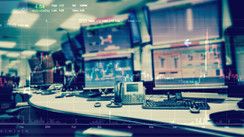In the fast-paced world of stock trading, automated trading systems have carved a niche for themselves. Sometimes known as algorithmic trading or system trading, these systems empower traders to set precise rules for trade initiation and closure. Once these rules are encoded, they are automatically enforced by a computer, eliminating the need for manual intervention. It's interesting to note that a significant chunk of shares traded on U.S. stock exchanges – as much as 70% to 80% - are attributed to automatic trading systems.
Traders and investors can convert their exact entry, exit, and financial management strategies into automated trading systems, allowing computers to oversee and manage trades. One of the primary perks of strategy automation is its ability to mitigate the emotional component of trading. Once predetermined criteria are met, trades are automatically executed.
The regulations for entering and exiting trades can be predicated on straightforward conditions like a moving average crossover, or they might involve complex strategies necessitating an in-depth comprehension of the programming language specific to a user's trading platform. In some cases, these rules can be designed with the help of a skilled programmer.
Implementing automated trading systems usually involves the use of software connected to a direct access broker, with any particular rules needing to be coded in the platform's unique language. For instance, the TradeStation platform uses the EasyLanguage programming language, while NinjaTrader employs NinjaScript.
Setting Up Trading "Rules"
Several trading platforms feature strategy-building "wizards" that enable users to select from a list of commonly used technical indicators to develop a set of rules for automated trading. Traders can define rules like entering a long position trade when the 50-day moving average crosses over the 200-day moving average on a specific trading instrument's five-minute chart. Users can further define the kind of order (like market or limit) and the trigger for the trade.
However, many traders prefer to code their custom indicators and strategies. This approach, while more labor-intensive than using the platform's wizard, allows for greater flexibility and potentially more rewarding outcomes. As with any aspect of trading, no investment strategy is foolproof or guaranteed to succeed.
Once the rules are in place, the computer scans the markets for buying or selling opportunities based on the trading strategy's specifications. In the event of a trade, protective stop losses, trailing stops, and profit targets are automatically generated. This swift order entry can be crucial in rapidly moving markets, potentially averting major losses if the trade goes against the trader.
Benefits of Automated Systems
Automated trading systems offer numerous advantages that have contributed to their popularity among investors and traders.
Curbing Emotions
One of the biggest challenges traders face is managing emotions. Fear and greed can drive rash decisions that lead to losses. Automated trading systems effectively neutralize emotions during the trading process, helping traders stick to their plan. Since trades are executed automatically once predefined rules are met, it leaves no room for hesitation, doubt, or second-guessing, reducing the risk of impulse trades or overtrading. This emotionless approach promotes a more disciplined and objective trading approach.
Backtesting
Backtesting is a powerful feature of automated trading systems. It allows traders to apply their trading rules to historical market data to determine the feasibility of their strategy. This process helps traders evaluate and refine a trading idea before putting money at risk. Traders can ascertain how the system would have performed in different market conditions and tweak their rules and parameters to optimize performance. By assessing a strategy's performance in past market conditions, traders can determine the system's expectancy - the average gain or loss per unit of risk - which is a valuable indicator of the system's potential effectiveness.
Maintaining Discipline
Automated trading systems help ensure discipline as the trading plan is followed precisely, trade after trade. In the heat of the moment, traders can make errors - entering the wrong quantity, skipping trades out of fear, or not following the trading plan. By setting out the rules and letting the system execute the trades, the chance of such "pilot errors" is significantly reduced. Even in volatile markets, when it's tempting to deviate from the plan, discipline is preserved because the system continues to follow the set rules.
Enhancing Order Entry Speed
Financial markets move quickly, and timing is crucial. Automated systems, due to their instantaneous response to market changes, can execute orders as soon as the trade criteria are met. This rapid execution is particularly useful in fast-moving markets where price conditions can change rapidly, potentially affecting the profitability of a trade. The swift order entry afforded by automated systems can help traders get in or out of trades at optimal times.
Diversifying Trading
One key advantage of automated trading systems is their ability to handle multiple accounts and different strategies simultaneously. This ability allows traders to diversify their trading, spreading risk across different instruments and strategies, and can help to create a hedge against losing positions. For instance, one system may be dedicated to trend-following, while another may be designed for mean-reversion. This multi-system, multi-market approach can reduce the exposure to market downturns and enhance the potential for returns.
Consistent Trading
Automated trading systems can implement strategies with precise consistency. Since every trade is executed according to set rules, traders can be sure that their strategy is being followed to the letter. This consistency removes the potential for human errors and ensures that the strategy's rules are applied in each trade, regardless of the market conditions or the trader's emotional state.
24/7 Trading
Automated systems can operate round the clock, taking advantage of trading opportunities in different time zones and markets, which is particularly beneficial in the forex market, which operates 24 hours a day. This aspect means traders are not constrained by their time zone or daily commitments and can potentially profit from trading opportunities that they would otherwise miss.
In conclusion, automated trading systems offer a host of benefits that can help traders implement their strategies effectively, manage their risk, and potentially increase their returns. However, they are not a magic bullet and require careful setup, monitoring, and occasional adjustment to perform optimally.
Potential Downsides of Automated Systems
While automated trading systems offer many advantages, they also come with certain downsides that should be considered before adoption.
System Failure
The possibility of mechanical or technological failure is an inherent risk with automated trading systems. A connectivity issue, power outage, computer crash, or a bug in the system can lead to missed trades or orders not being executed according to the set rules. Even minor glitches can result in substantial financial losses. Therefore, the reliability of the hardware, software, and internet connection is critical in automated trading.
Over-Optimization
An over-optimized system works well on historical data but may fail in real trading. Over-optimization occurs when a system is fine-tuned to perform exceptionally well based on past market data, but it becomes too complex and specific to replicate that success in real-world market conditions. These over-optimized systems often fail when faced with new market conditions, leading to underperformance or losses.
Lack of Control
When using an automated trading system, traders have less control over their trades. This can be a potential downside for traders who prefer to be hands-on and make real-time decisions. Once the system is programmed and activated, it will trade according to its parameters, and altering its course in the middle of trading can be challenging.
Requires Monitoring
Despite the automatic nature of these systems, they still require monitoring. Changes in market conditions could lead to an increase in orders that are filled at undesirable levels. Furthermore, anomalies, such as system quirks or abnormal market conditions, can result in trades not being executed as intended. Therefore, supervision is essential to avoid potential trading mishaps.
Absence of Intuitive Decision Making
Automated systems are algorithmic and follow pre-set rules, which means they lack the ability to incorporate intuition or spontaneous judgment calls that a human trader might make based on experience or market insight. They may struggle to respond to sudden shifts in market conditions or 'black swan' events that have not been programmed into their algorithms.
Cost
Automated trading systems can be expensive. They often come with high setup costs, including software purchase or subscription fees, hardware expenses, and potential ongoing costs for updates and maintenance. Furthermore, if you're not able to develop the system yourself, you might need to hire a developer, which adds to the overall cost.
False Sense of Security
Automated systems might give traders a false sense of security, leading them to overlook potential risks. The fact that the system has been backtested and has worked well in the past doesn't guarantee future success. Market conditions can change rapidly and dramatically, and the system might not adapt well to these changes.
In conclusion, while automated trading systems have many benefits, they are not without their drawbacks. It is crucial for traders to understand these potential pitfalls before deciding to use automated trading systems. One must monitor the systems and be prepared to intervene as necessary while ensuring the systems are not over-optimized and are tested across different market conditions.
Points to Ponder Before Automation
Before embarking on the journey of automated trading, there are several critical aspects you need to reflect upon. Familiarizing yourself with the intricacies of the system, starting with uncomplicated strategies initially, and comprehending your preferred method are all vital steps.
Knowing the System
Before deploying an automated trading system, it's important to understand the system's functionality and logic thoroughly. You need to be clear about how the system analyzes markets, makes trading decisions, and executes trades. It's advisable to first test the system using a demo account to see how it performs under different market conditions.
Keep It Simple
When starting with automated trading, it's best to stick with simple strategies. As you gain more experience and understanding of how the system works, you can gradually start using more complex strategies.
Understanding Your Strategy
You should be clear about what your trading strategy is and how it's going to be implemented by the automated system. You should also be prepared to adjust your strategy based on the system's performance and changes in market conditions.
Final Thoughts
While automated trading systems come with a plethora of benefits, they shouldn't be viewed as a substitute for mindful and deliberate trading. The possibility of technological disruptions implies that these systems demand continuous monitoring, and traders should possess adequate trading experience and knowledge before deciding to use automated systems.
Automated trading systems have their place in a trader's toolbox, but they are just one tool among many. They can help traders execute strategies precisely and efficiently, but they don't replace a trader's knowledge, experience, and intuition. As a trader, your ultimate success depends on your ability to understand the market, make wise trading decisions, and manage your risk effectively – whether you're trading manually or using an automated system.
Always remember that markets can be unpredictable and that no system – automated or not – can guarantee profits. You should be prepared to handle losses and work continuously to improve your trading skills and strategies.





